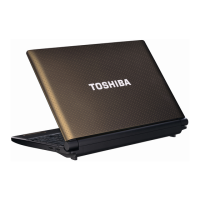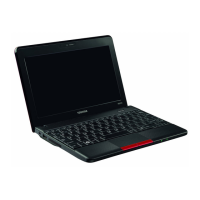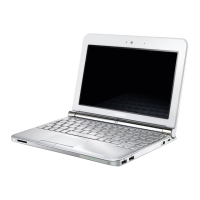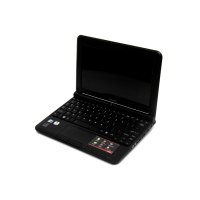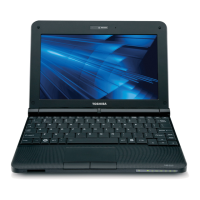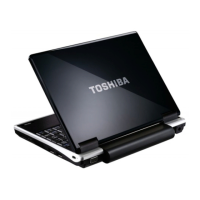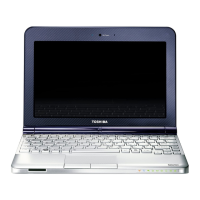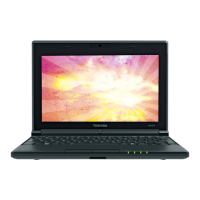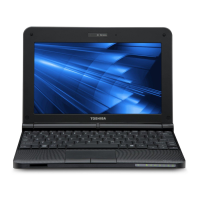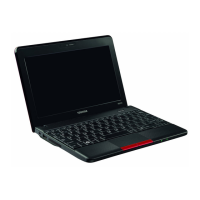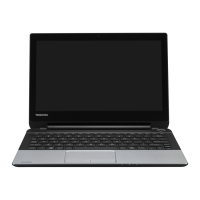
Do you have a question about the Toshiba NB 100 Series and is the answer not in the manual?
Lists all items included with the computer for verification upon unboxing.
Details the physical hardware components of the NB 100 series computer.
Lists preinstalled software, operating system, utilities, and accompanying user guides.
Covers key computer components including processor, memory, storage, input devices, ports, and connectivity.
Identifies components on the front of the computer when the display panel is closed.
Identifies components located on the left side of the computer.
Identifies components located on the right side of the computer.
Identifies components located on the back side of the computer.
Identifies components located on the underside of the computer.
Identifies components on the front of the computer when the display panel is open.
Explains the function of various system indicator lights on the computer.
Describes the AC adaptor and its connection for powering the computer and charging the battery.
Step-by-step instructions for connecting the AC adaptor to power the computer.
Guidance on how to properly open and adjust the computer's display panel.
Explains how to turn the computer on and the different modes for turning it off.
Instructions for the first-time power-on sequence and operating system setup.
Provides methods for restarting the computer when issues arise or settings change.
Details how to create recovery discs and restore the system's preinstalled software.
Instructions on operating the touchpad for pointer control and selection.
Information on creating CDs/DVDs and verifying written data using TOSHIBA Disc Creator.
Details on using the built-in webcam and microphone for capturing images and audio.
Covers Wireless LAN, Bluetooth technology, and wireless communication status indicators.
Instructions for connecting and disconnecting the computer to a Local Area Network.
Guidance on cleaning, moving, and managing heat dispersal for the computer.
Describes typewriter, function, and soft keys on the computer's keyboard.
Explains emulation, hot keys, special Windows keys, and Fn key combinations.
Explains the numeric keypad overlay, turning it on, and numeric mode operation.
Details power states, battery charge status, and indicator light meanings.
Covers battery types, care, charging, monitoring, maximizing life, and replacement procedures.
Explains power-up modes like Boot, Hibernation, Standby, and password settings.
Explains how to enter and navigate the BIOS Setup Menu for system configuration.
Details on setting and managing user and supervisor passwords within BIOS.
Describes how to change the computer's boot device priority in BIOS.
Configuration options for USB Legacy Support and USB Sleep and Charge functionality.
Configuration options for the Wake-up on LAN feature for network booting.
Information on installing and using memory modules, SD/MS/MS Pro cards, and SIM cards.
Details on purchasing and using additional battery packs and AC adaptors.
Information on connecting external devices like USB FDD kits and monitors.
Instructions for attaching a security lock to prevent unauthorized removal of the computer.
Guidelines for identifying and resolving computer problems effectively.
Covers initial troubleshooting steps and analyzing symptoms to identify the root cause.
Steps to diagnose and resolve issues related to software and operating system errors.
Provides troubleshooting steps for common hardware issues with computer components and peripherals.
Guidance on contacting TOSHIBA support and finding contact information for hardware-related issues.
Disclaimers related to CPU, Memory, HDD Capacity, LCD, GPU, and Wireless LAN performance.
Disclaimers regarding non-applicable icons, copy protection, and USB Sleep and Charge functionality.
Details physical dimensions and environmental operating requirements for the computer.
Specifies the AC adaptor voltage and frequency, and the computer's DC input requirements.
Explains how the display controller interprets software commands for graphics and video output.
Details card specifications, compatibility, media access, data rates, and radio characteristics for Wireless LAN.
Lists required specifications for AC power cords, including length, wire size, and current/voltage ratings.
Details certification agencies for power cords and shows plug shapes for various regions.

